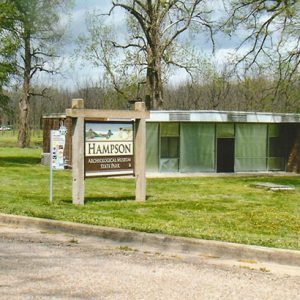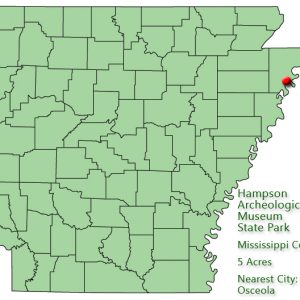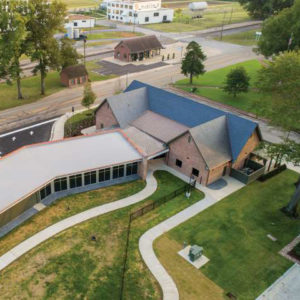calsfoundation@cals.org
Hampson Archeological Museum State Park
| Location: | Mississippi County |
| Area: | 5 acres |
Hampson Archeological Museum State Park houses and exhibits the archaeological collection from a Mississippian era ceremonial complex and village known as the Nodena Site, located in Wilson (Mississippi County) and originally uncovered by Dr. James K. Hampson. This remarkable collection is accompanied by graphics and written material describing the lifestyles of the artistic people who lived here from AD 1400 to 1650.
As a boy, Hampson (1877–1956) was fascinated by arrowheads. His interest in archaeology was rekindled in the early 1920s, when he returned to the family plantation, Nodena, to set up a successful medical practice. In 1927, he began a painstaking study of the physical remains of the people who inhabited the Nodena Site. Hampson, his wife, and his children excavated and carefully documented portions of the Nodena Site. Their well-documented discoveries led to national recognition for Hampson and major excavations by the University of Arkansas and the Alabama Museum of Natural History. The two entities excavated, surveyed, inventoried, and cataloged many Late Mississippian Period artifacts from the site throughout the early 1930s up to the 1970s, including a 1973 field school that was held at the same location. More recent is the work of Dr. Dan F. Morse of the Arkansas Archeological Survey, who has published a written account of the vast archeological work done at Nodena.
The original museum was constructed on Hampson’s Nodena plantation in 1946 and named the “Henry Clay Hampson Memorial Museum” in honor of the Hampson’s son, who was killed in action flying over Burma during World War II. The museum collection numbered over 40,000 artifacts when Hampson died on October 8, 1956. The collection stayed in the old wooden facility during the 1950s, until a building next to the museum burned. The Hampson family promptly offered the collection to the state. Approved as a park by Legislative Act 564 on March 30, 1957, Hampson Museum State Park was dedicated in 1961 and underwent a major renovation in 1978. The changes not only allowed for more scientific study by archaeological scholars but also made the museum more interesting for visitors of all ages. Exhibits explore village life before European exploration, and a representation of the vast trade territory which existed throughout the ancient Midwest and South between other Mississippian cultural sites is depicted by the different indigenous resources documented from these geographical locations.
The Upper Nodena Cultural Site, located on a meander bend of the Mississippi River, was a fifteen-acre palisaded village. A plaza used in ceremonies connected two ceremonial mounds and associated structures. South of the plaza was an area possibly used as a playing field for a game called chunky. Adjacent to and south of the playing field was a third mound. Surrounding this ceremonial area was the village, which included houses and family cemeteries. It has been estimated that approximately 1,100 to 1,650 people could have lived at Nodena.
The Nodena people cultivated corn, beans, and squash. These foods were supplemented by hunting and fishing. White-tailed deer, raccoon, muskrat, squirrel, and rabbit provided food, as well as skins and bones for tools, jewelry, and gaming dice. Cane was used for thatch roofs, building materials, fishing traps, and arrow shafts and could be used as fuel for fire. Hardwood (bald cypress, oak, and cottonwood) was used for canoes, tools, and larger weapons, such as knives, spears, atl-atls, and bows.
Local backswamp clays were used in the elaborate pottery vessels the Mississippian culture has become known for, including the beautiful type-site pottery—Nodena Red and White. Stone for tools and weapons was imported from the north, and the trade network also brought shells from the Gulf of Mexico and salt from Missouri.
A five-acre site was donated for the museum by Robert E. Lee Wilson III, a northeast Arkansas entrepreneur. It offered an opportunity for the public to view the thousands of artifacts excavated from the Nodena cultural site: effigy vessels, bowls, jars, bottles, Red and White Nodena ceramic vessels, as well as the Nodena Willow Leaf Point, and many stone farming tools to include hoes and celts.
In 2004, the state park museum underwent another name change, becoming Hampson Archeological Museum State Park to offer visitors traveling the I-55 corridor a greater cultural and historical identity. In 2015, ground was broken on a new site for the park on the town square, and the museum was closed in late 2017 in preparation for reopening in the new complex.
Hampson Archeological Museum State Park is one of three archaeological state parks that interpret different Mississippian time periods. The state park/museum is only a few miles off the I-55 interstate and is worth the drive to visit one of the nation’s premier Late Mississippian Period ceramic vessel collections known to exist.
For additional information:
Arkansas State Parks–Hampson Archeological Museum. http://www.arkansasstateparks.com/hampsonmuseum/ (accessed July 21, 2023).
Arkansas State Parks. A Legacy Worth Saving. Little Rock: Arkansas State Parks Publication, 1996.
Morse, Dan F. Nodena: An Account of 90 Years of Archeological Investigation in Southeast Mississippi County, Arkansas. Research Series No. 30. Fayetteville: Arkansas Archeological Survey, 1989.
Roberts, Jeannie. “Crews Readying New Wilson Museum.” Arkansas Democrat-Gazette, September 2, 2018, pp. 1B, 8B.
The Virtual Hampson Museum. http://hampsonmuseum.cast.uark.edu/ (accessed July 21, 2023).
Marlon Mowdy
Hampson Archeological Museum State Park
 Hampson Archeological Museum State Park
Hampson Archeological Museum State Park  Hampson Archeological Museum State Park: Park Location
Hampson Archeological Museum State Park: Park Location  Hampson Archeological Museum State Park
Hampson Archeological Museum State Park 




Comments
No comments on this entry yet.